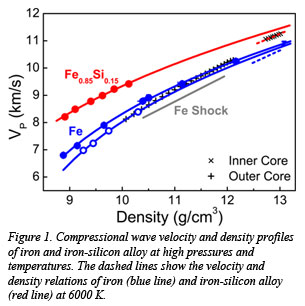 Earth’s inner core is by far the most remote region of the planet and exists at conditions of over 3.6 million atmospheres (360 GPa) pressure and temperatures perhaps in the 6000 K range. While remote, its existence affects the geodynamo and how the Earth’s interior has evolved through time. A number of enigmatic properties of the Earth’s inner core have been recently discovered, including variable seismic speeds in the inner core and differential super-rotation in which Earth’s inner core is observed to be rotating at a different speed from the rest of the planet. Deciphering these observations requires a knowledge of the composition of the Earth’s inner core and the sound velocities and densities of candidate iron alloys at high pressures and temperatures.
Earth’s inner core is by far the most remote region of the planet and exists at conditions of over 3.6 million atmospheres (360 GPa) pressure and temperatures perhaps in the 6000 K range. While remote, its existence affects the geodynamo and how the Earth’s interior has evolved through time. A number of enigmatic properties of the Earth’s inner core have been recently discovered, including variable seismic speeds in the inner core and differential super-rotation in which Earth’s inner core is observed to be rotating at a different speed from the rest of the planet. Deciphering these observations requires a knowledge of the composition of the Earth’s inner core and the sound velocities and densities of candidate iron alloys at high pressures and temperatures.
A team of CDAC scientists has measured the compressional-wave velocity and density of iron and iron-silicon alloy at pressures over a megabar and at high temperatures to understand the physical and chemical properties of the core. The group consisted of CDAC partner Jung-Fu Lin, CDAC student Jeff Liu, and former CDAC student Zhu Mao (Princeton, now a postdoctoral associate at UT Austin), CDAC Associate Director Ho-kwang Mao (Carnegie), and colleagues at the  Advanced Photon Source. The experiments were carried out using the diamond anvil cell and advanced inelastic x-ray scattering and x-ray diffraction techniques. Results from these measurements show that high temperature significantly decreases the compressional-wave velocity of iron in the hexagonal close packed structure at high pressures, and the iron-silicon alloy exhibits similar high-pressure behavior to pure iron with a constant density offset. Together with the published results, the group has created a new velocity-density model of iron alloys to constrain the chemical composition using seismic observations of the Earth’s core. Indications are that Earth’s inner core, with approximately 8 wt% silicon can have a velocity-density profile at 6000 K that matches well with seismic observations in the region (Fig. 1). [Z. Mao et al., Proc. Nat. Acad. Sci. doi:10.1073/pnas.1207086109 (2012)].
Advanced Photon Source. The experiments were carried out using the diamond anvil cell and advanced inelastic x-ray scattering and x-ray diffraction techniques. Results from these measurements show that high temperature significantly decreases the compressional-wave velocity of iron in the hexagonal close packed structure at high pressures, and the iron-silicon alloy exhibits similar high-pressure behavior to pure iron with a constant density offset. Together with the published results, the group has created a new velocity-density model of iron alloys to constrain the chemical composition using seismic observations of the Earth’s core. Indications are that Earth’s inner core, with approximately 8 wt% silicon can have a velocity-density profile at 6000 K that matches well with seismic observations in the region (Fig. 1). [Z. Mao et al., Proc. Nat. Acad. Sci. doi:10.1073/pnas.1207086109 (2012)].
